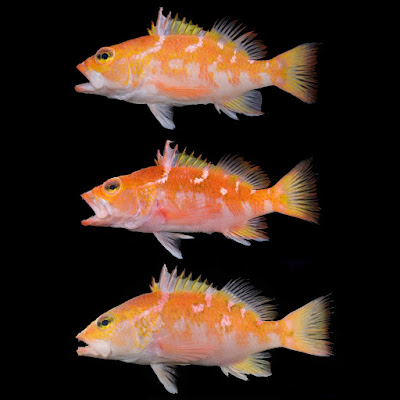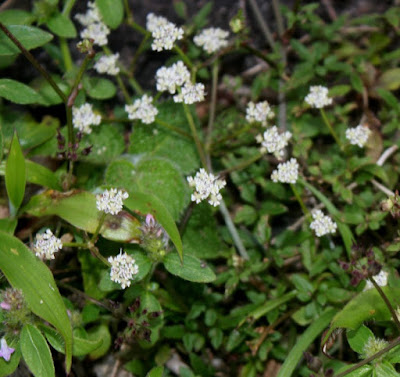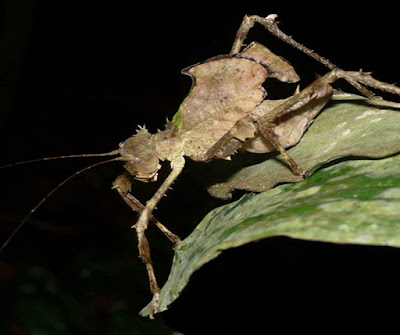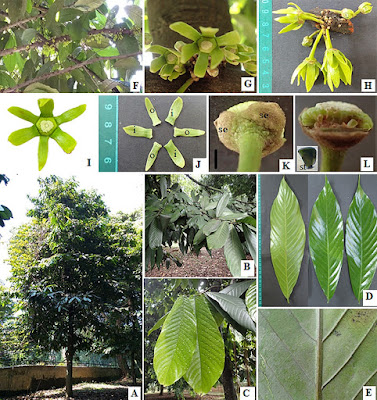[Most Recent Entries] [Calendar View]
Tuesday, May 26th, 2020
| Time | Event | ||||||
| 2:38a | [Ichthyology • 2020] Plectranthias purpuralepis • A New Anthiadine Perchlet (Perciformes: Serranidae) from northern Taiwan
Abstract A new species of Plectranthias Bleeker is described on the basis of 16 specimens collected from northern Taiwan. The new species, Plectranthias purpuralepis sp. nov. can be distinguished from its congeners in having pectoral and pelvic fins mostly covered with small scales, some white scales on dorsum turn purple when preserved, and the following combination of characters: dorsal-fin elements X, 16–17; 3rd dorsal-fin spine longest; pectoral-fin rays 14, all branched except for uppermost simple ray; principal caudal-fin rays 9+8; pored lateral-line scales 33–36; 6 diagonal rows of large scales on cheek; circumpeduncular scales 14; ca. 7 rows of large predorsal scales, 2 irregular rows of small scales extending to a line through posterior nostrils; no scales on maxilla and chin; posterior margin of preopercle serrated, ventral margin with 2 antrorse spines; and the greatest body depth 2.9–3.0 in SL. Keywords: Pisces, Teleostei, Actinopterygii, taxonomy, ichthyology
Plectranthias purpuralepis sp. nov. New English name: Purple-scaled perchlet Diagnosis. A species of Plectranthias with pectoral and pelvic fins mostly covered by small scales and scales on the whitish pink blotches turn purple when preserved. It can be further separated from congeners by having the combination of following characters: dorsal-fin elements X, 16–17; 3rd dorsal-fin spine longest; pectoral-fin rays usually 14, all branched except for uppermost ray simple; principal caudal-fin rays 9+8; pored lateral-line scales 32–36; 6 diagonal rows of large scales on cheek; circumpeduncular scales 14; ca. 7 rows of large predorsal scales, 2 irregular rows of small scales extending to a line through posterior nostrils; no scales on maxilla and chin; posterior margin of preopercle serrated, ventral margin with 2 antrorse spines; and greatest body depth 32.6–35.1% SL. Distribution and habitat. Only known from northern Taiwan, near the “Three Northern Islands,” collected by anglers at depths of 200 m or below, judging from other specimens collected together, such as Parapercis spp., Plectranthias kamii, P. sheni, and Helicolenus hilgendorfii (Döderlein, 1884). The habitat of this species is assumed to be rocky reef bottom or slope in the mesophotic zone. Etymology. The specific name purpuralepis is a combination of the Latin “purpura” and “lepis,” meaning purple scales, in reference to the distinct purple color only present after preservation. The name is treated as a noun in apposition. Chi-Ngai Tang, Nok-Wai Lai and Hsuan-Ching Ho. 2020. Plectranthias purpuralepis sp. nov., A New Anthiadine Perchlet from northern Taiwan (Perciformes: Serranidae). Zootaxa. 4780(3); 508–522. DOI: 10.11646/zootaxa.4780.3.4 | ||||||
| 9:47a | [Botany • 2020] Peucedanum pradeepianum (Apiaceae: Apioideae) • A New Species from Western Ghats, India
Abstract A new species, Peucedanum pradeepianum KMP Kumar, Hareesh & Indu sp. nov. from Western Ghats of Kerala, is described and illustrated. The new species is closely related to P. anamallayense and P. dhana var. dhana, but differs in having deeply serrate leaflets, broadly ovate bract, ovate-lanceolate, acute bracteoles, and 3–4 lateral and 4 commissural vittae. Keywords: Novelty, IUCN Red List, south India, Eudicots Konickal Mambetta Prabhukumar, Vadakkoot Sankaran Hareesh, Ram Pradeep and Indira Balachandran. 2020. Peucedanum pradeepianum (Apiaceae: Apioideae), A New Species from Western Ghats, India. Phytotaxa. 446(1); 43–48. DOI: 10.11646/phytotaxa.446.1.5 | ||||||
| 10:03a | [Entomology • 2020] Orthoptera Tettigoniidae (Conocephalinae, Hexacentrinae, Phaneropterinae, Mecopodinae, Hetrodinae) from Some Protected Areas of Central African Republic
Abstract This paper is a contribution to the distribution, taxonomy and phenology of Orthoptera Tettigoniidae of Central African Republic. Thanks to scientific expeditions and entomological missions, 2155 Orthoptera belonging to 118 species of five subfamilies of Tettigoniidae have currently been studied. Examined material is here listed with its known distribution. New genera and species have been found and here described: Eurycoplangiodes sanghaensis Massa, n. gen. and n. sp. Paraeulioptera emitflesti Massa, n. gen. and n. sp., Paraeurycorypha Massa, n. gen. ocellata Massa et Annoyer, n. sp., Arantia (Arantia) gretae Massa, n. sp., Arantia (Euarantia) syssamagalei Massa et Annoyer, n. sp. and Dapanera brevistylata Massa, n. sp. Overall, from 2012 to 2020, the study of the orthopteran material collected in the scientific expeditions to Central Africa carried out since 1984, enabled the description of 6 new genera and 27 new species. They represent 22.8% of the total amount of species currently recorded in the protected areas where this scientific activity has been carried out. This demonstrates that these areas still hold a high number of new species, representing a biodiversity hotspot. Keywords: Orthoptera, Central African Republic, Dzanga-Sangha Special Reserve, Dzanga-Ndoki National Park, New taxa, Taxonomy, Distribution
Bruno Massa, Philippe Annoyer, Cyrille Perez, Samuel Danflous and Guilhem Duvot. 2020. Orthoptera Tettigoniidae (Conocephalinae, Hexacentrinae, Phaneropterinae, Mecopodinae, Hetrodinae) from Some Protected Areas of Central African Republic. Zootaxa. 4780(3); 401–447. DOI: 10.11646/zootaxa.4780.3.1 | ||||||
| 10:29a | [Botany • 2020] Monoon kalimantanense (Annonaceae) • A New Species from Kalimantan, Borneo, Indonesia
During the study of Monoon Miquel (1865: 15) in western Malesia, we found two individuals of this genus cultivated in the Bogor Botanic Garden. According to the catalogue An alphabetical list of plant species cultivated in the Bogor Botanic Gardens, these plants were collected from South Kalimantan in 1977 (Sari et al. 2010). Leaves and aggregate fruits of these plants indicated that they are a species of Monoon (Annonaceae). The leaves exhibit eucamptodromous venation, decurrent insertion of secondary veins, and scalariform tertiary veins. The aggregate fruits consist of many one-seeded, stalked monocarps. However, other characters indicated that they differ from already known Monoon species. We consider these plants, therefore as new to science. This new species shares characters with M. lateriflorum (Blume) Miquel (1865: 19), previously Guatteria lateriflora Blume (1825: 20) and M. sclerophyllum (Hook. & Thomson) Xue & Saunders in Xue et al. (2012: 1033), previously Polyalthia sclerophylla Hooker & Thomson (1872: 65), in having ramiflorous, fasciculate inflorescences, many-flowered fascicles, oblong petals slightly constricted basally and many-stipitate monocarps (ca. 30) in aggregate fruits. However, other characters of leaves, flowers, and monocarps indicate that this new material differs from M. lateriflorum, and M. sclerophyllum (Table 1). Keywords: plant taxonomy, taxonomic revision, Annonaceae, Monoon, Magnoliids Monoon kalimantanense Nurmawati, sp. nov. Small trees, leaves 35–49 cm long. Inflorescences ramiflorous, with many flowers, stigma surface densely curly hairy. Inflorescences position and monocarp of Monoon kalimantanense is similar to M. lateriflorum and M. sclerophyllum but differs in having larger leaves with a rounded base, green pedicels, broadly triangular and densely hairy sepals, shorter oblong petals and monocarps slightly asymmetrically attached on the stipe. Distribution, habitat, and ecology:— Known only from the Bogor Botanical Garden, most probably originally in South Kalimantan, Meratus Mts, near Muara Uja, Jaro Dam. The plants cultivated in the Garden have full exposure to sunlight with an average rainfall of 3000 to 4000 mm annually. Etymology:— Referring to its provenance in South Kalimantan. Subekti Nurmawati, Nunik Sri Ariyanti, Tatik Chikmawati and Paul J. A. Kessler. 2020. Monoon kalimantanense (Annonaceae), A New Species from Kalimantan, Borneo, Indonesia. Phytotaxa. 446(1); 1–5. DOI: 10.11646/phytotaxa.446.1.1 |
| << Previous Day |
2020/05/26 [Calendar] |
Next Day >> |











